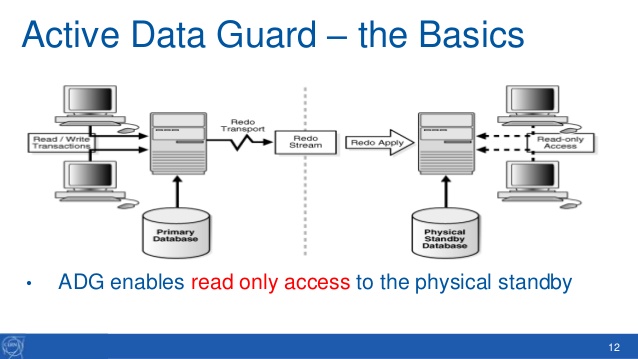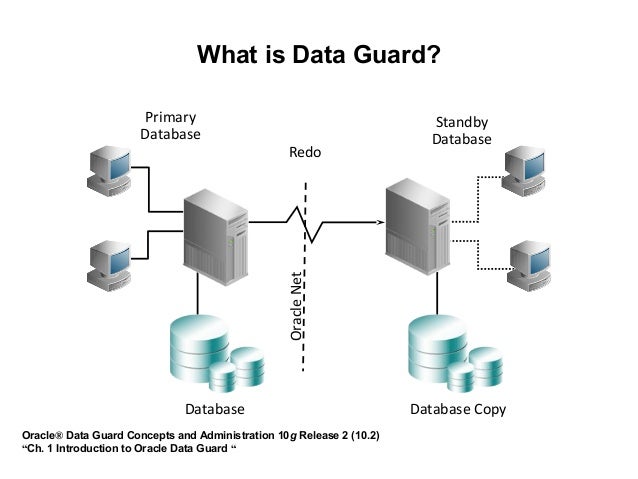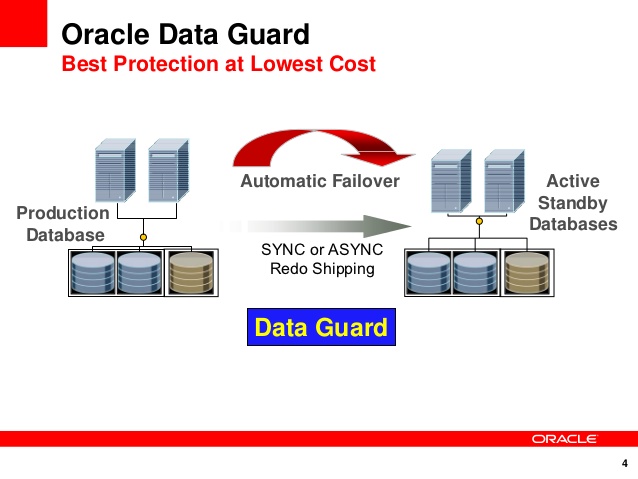What is Oracle Active Data Guard and How Does it Work?
Oracle Active Data Guard is a disaster recovery and high availability solution that provides real-time data protection and load balancing for Oracle databases. It operates as a standby database that can be used for reporting and backups, providing a cost-effective way to ensure business continuity and data availability. With Oracle Active Data Guard, you can automatically failover to the standby database in case of a disaster, ensuring minimal downtime and data loss. Additionally, it provides read-only access to the standby database, allowing you to offload read workloads and improve database performance.
Key Features and Benefits of Oracle Active Data Guard
Oracle Active Data Guard is a powerful disaster recovery and high availability solution that offers numerous features and benefits for businesses. Some of the main features and advantages of Oracle Active Data Guard include automatic failover, data protection, and read-only access to the standby database. With automatic failover, you can ensure minimal downtime and data loss in case of a disaster, as the standby database will automatically take over. Data protection is also a key benefit of Oracle Active Data Guard, as it provides real-time data protection, ensuring that your data is always safe and secure. Additionally, read-only access to the standby database allows you to offload read workloads and improve database performance, making it an ideal solution for businesses that require high availability and data protection.
Oracle Active Data Guard vs. Oracle Data Guard: A Comparison
Oracle Active Data Guard and Oracle Data Guard are both powerful disaster recovery and high availability solutions for Oracle databases. However, they have some key differences that make them more appropriate for different scenarios. Oracle Data Guard is a disaster recovery solution that provides a standby database for backup and recovery purposes. It offers real-time data protection, but it does not provide automatic failover or read-only access to the standby database. Oracle Active Data Guard, on the other hand, is a more advanced solution that offers automatic failover, data protection, and read-only access to the standby database. It is designed for businesses that require high availability and real-time data protection, making it an ideal solution for mission-critical applications.
When choosing between Oracle Active Data Guard and Oracle Data Guard, consider the level of availability and data protection you require. If you need automatic failover and real-time data protection, Oracle Active Data Guard is the better choice. However, if you only need a standby database for backup and recovery purposes, Oracle Data Guard may be a more cost-effective solution. Additionally, consider the complexity of the implementation and the level of expertise required to manage and maintain the solution. Oracle Active Data Guard is a more advanced solution that requires a higher level of expertise, while Oracle Data Guard is a more straightforward solution that is easier to implement and manage.
How to Implement Oracle Active Data Guard: A Step-by-Step Guide
Implementing Oracle Active Data Guard can provide significant benefits for your business, including real-time data protection, disaster recovery, and load balancing. However, the implementation process can be complex, and it is important to follow best practices to ensure a successful deployment. Here is a step-by-step guide to implementing Oracle Active Data Guard:
-
Check system requirements: Before implementing Oracle Active Data Guard, ensure that your system meets the minimum requirements, including hardware, software, and network configurations.
-
Configure the standby database: Create a standby database and configure it to be in real-time synchronization with the primary database. This can be done using the Data Guard Broker or manually.
-
Test the standby database: Test the standby database to ensure that it is functioning correctly and that it can take over as the primary database in case of a failure.
-
Configure automatic failover: Configure automatic failover to ensure that the standby database takes over as the primary database in case of a failure.
-
Configure load balancing: Configure load balancing to distribute workloads between the primary and standby databases, improving database performance and availability.
-
Monitor and maintain the system: Regularly monitor and maintain the system to ensure that it is functioning correctly and that any issues are addressed promptly.
When implementing Oracle Active Data Guard, it is important to follow best practices, such as testing the standby database, configuring automatic failover, and regularly monitoring and maintaining the system. Additionally, consider working with an experienced database administrator or consultant to ensure a successful deployment.
Oracle Active Data Guard Use Cases: Real-World Examples
Oracle Active Data Guard is a powerful solution that offers numerous benefits for businesses in various industries and applications. Here are some real-world examples of how Oracle Active Data Guard is used to improve database performance, availability, and security:
Financial Services
Financial institutions rely heavily on their databases for critical operations such as transaction processing and regulatory reporting. Oracle Active Data Guard provides real-time data protection and disaster recovery, ensuring that financial institutions can continue to operate even in the event of a disaster. Additionally, Oracle Active Data Guard enables financial institutions to offload read workloads to the standby database, improving database performance and reducing response times for critical applications.
Healthcare
Healthcare organizations must comply with strict regulations regarding data privacy and security. Oracle Active Data Guard provides real-time data protection and disaster recovery, ensuring that healthcare organizations can continue to operate and maintain compliance even in the event of a disaster. Additionally, Oracle Active Data Guard enables healthcare organizations to use the standby database for reporting and backups, improving database availability and reducing the burden on the primary database.
Retail
Retailers rely heavily on their databases for critical operations such as inventory management and sales tracking. Oracle Active Data Guard provides real-time data protection and disaster recovery, ensuring that retailers can continue to operate even in the event of a disaster. Additionally, Oracle Active Data Guard enables retailers to offload read workloads to the standby database, improving database performance and reducing response times for critical applications.
Manufacturing
Manufacturers rely heavily on their databases for critical operations such as supply chain management and quality control. Oracle Active Data Guard provides real-time data protection and disaster recovery, ensuring that manufacturers can continue to operate even in the event of a disaster. Additionally, Oracle Active Data Guard enables manufacturers to use the standby database for reporting and backups, improving database availability and reducing the burden on the primary database.
These are just a few examples of how Oracle Active Data Guard is used in various industries and applications. By providing real-time data protection, disaster recovery, and load balancing, Oracle Active Data Guard can help businesses improve database performance, availability, and security, leading to improved business outcomes and a competitive advantage.
Oracle Active Data Guard Best Practices: Tips and Recommendations
Oracle Active Data Guard is a powerful solution that offers numerous benefits for businesses, including real-time data protection, disaster recovery, and load balancing. To ensure optimal performance, availability, and security, it is important to follow best practices when implementing and managing Oracle Active Data Guard. Here are some tips and recommendations:
Regular Maintenance
Regular maintenance is essential to ensure the smooth operation of Oracle Active Data Guard. This includes monitoring the system for errors, applying patches and updates, and performing backups and restores. By performing regular maintenance, you can identify and address issues before they become critical, ensuring the availability and reliability of your database environment.
Monitoring and Alerts
Monitoring and alerts are critical to ensuring the availability and performance of Oracle Active Data Guard. By monitoring the system and setting up alerts, you can quickly identify and address issues before they become critical. This includes monitoring the primary and standby databases, the network, and the operating system. Additionally, it is important to monitor the performance of Oracle Active Data Guard, including CPU usage, memory usage, and I/O activity, to ensure optimal performance.
Testing
Testing is essential to ensure the reliability and availability of Oracle Active Data Guard. This includes testing the failover process, the standby database, and the disaster recovery process. By regularly testing these processes, you can identify and address issues before they become critical, ensuring the availability and reliability of your database environment.
Security
Security is critical when implementing and managing Oracle Active Data Guard. This includes securing the primary and standby databases, the network, and the operating system. Additionally, it is important to implement access controls, encryption, and other security measures to protect your data and ensure compliance with regulations and industry standards.
Training and Education
Training and education are essential to ensure the successful implementation and management of Oracle Active Data Guard. This includes training for database administrators, system administrators, and other personnel involved in the management of the database environment. By ensuring that personnel are trained and educated on Oracle Active Data Guard, you can ensure a successful deployment and optimal performance, availability, and security.
By following these best practices, you can ensure optimal performance, availability, and security for Oracle Active Data Guard. Regular maintenance, monitoring, testing, security, and training and education are critical to ensuring the reliability and availability of your database environment. By implementing these best practices, you can maximize the benefits of Oracle Active Data Guard and improve business outcomes.
Oracle Active Data Guard Pricing and Licensing: What You Need to Know
Oracle Active Data Guard is a powerful solution that offers numerous benefits for businesses, including real-time data protection, disaster recovery, and load balancing. However, before implementing Oracle Active Data Guard, it is important to understand the pricing and licensing options available. Here is a comprehensive guide to help you make an informed decision.
Editions
Oracle Active Data Guard is available in two editions: Standard Edition and Enterprise Edition. The Standard Edition is designed for small to medium-sized businesses and includes basic features and functionality. The Enterprise Edition is designed for large enterprises and includes advanced features and functionality, such as automatic failover and real-time data protection.
Licensing Models
Oracle Active Data Guard is available through two licensing models: Processor-based and Named User Plus. The Processor-based licensing model is based on the number of processors in the server, while the Named User Plus licensing model is based on the number of named users or devices that access the software.
Factors Affecting Cost
The cost of Oracle Active Data Guard is affected by several factors, including the edition, licensing model, number of processors or named users, and support and maintenance contracts. Additionally, the cost may vary depending on the region and the specific needs of the business.
Choosing the Right Licensing Option
Choosing the right licensing option for Oracle Active Data Guard depends on several factors, including the size of the business, the number of processors or named users, and the specific needs of the database environment. It is important to carefully evaluate these factors and consult with an Oracle representative or authorized reseller to determine the best licensing option for your business needs.
Conclusion
Oracle Active Data Guard is a powerful solution that offers numerous benefits for businesses, including real-time data protection, disaster recovery, and load balancing. Understanding the pricing and licensing options available is essential to making an informed decision and ensuring a successful deployment. By carefully evaluating the edition, licensing model, number of processors or named users, and support and maintenance contracts, you can choose the right licensing option for your business needs and maximize the benefits of Oracle Active Data Guard.
Oracle Active Data Guard Future Developments: Trends and Innovations
Oracle Active Data Guard is a powerful and reliable solution for real-time data protection, disaster recovery, and load balancing. As technology continues to evolve, Oracle Active Data Guard is also advancing to meet the changing needs of businesses. Here are some of the future developments and innovations of Oracle Active Data Guard that you need to know.
Cloud Integration
Cloud integration is one of the most significant trends in database management, and Oracle Active Data Guard is no exception. Oracle is continuously working on integrating Oracle Active Data Guard with its cloud offerings, such as Oracle Cloud at Customer and Oracle Cloud Infrastructure. This integration will enable businesses to leverage the benefits of Oracle Active Data Guard in a cloud environment, providing greater flexibility, scalability, and cost savings.
Automation
Automation is becoming increasingly important in database management, and Oracle Active Data Guard is also advancing in this area. Oracle is developing new automation features for Oracle Active Data Guard, such as automated failover, automated disaster recovery, and automated load balancing. These features will help businesses to reduce the manual work required to manage Oracle Active Data Guard, improving efficiency, reducing errors, and increasing availability.
Machine Learning
Machine learning is another trend that is impacting database management, and Oracle Active Data Guard is also exploring its potential. Oracle is working on integrating machine learning algorithms into Oracle Active Data Guard to improve its predictive capabilities, such as predicting failures, identifying performance issues, and optimizing resource utilization. This integration will help businesses to proactively address issues before they become critical, improving availability, performance, and security.
Conclusion
Oracle Active Data Guard is a powerful and reliable solution for real-time data protection, disaster recovery, and load balancing. As technology continues to evolve, Oracle Active Data Guard is also advancing to meet the changing needs of businesses. By integrating with the cloud, automating processes, and leveraging machine learning, Oracle Active Data Guard will provide greater flexibility, scalability, and efficiency, helping businesses to stay competitive and achieve their goals.








